Does Your Bathroom Include a Shower or Bathtub?
This is the first question to consider because a half bath (just a sink and a toilet) has a lot less water to be worried about. There are still steps you’ll need to take to protect against water issues. But overall this is an easier bathroom to tackle.
Have a full bathroom? So did I, and I still installed vinyl plank flooring around the toilet and bathtub using a few steps I’ll show you.
Is There a Way To Waterproof Vinyl Plank Flooring?
Luxury vinyl plank flooring is a waterproof surface, but it’s also a floating floor. This means it needs expansion cracks along the walls which are then covered up by trim. In a room without a water source, that’s not a big deal but in a bathroom it’s a major factor to consider.
Existing Sheet Laminate Flooring
If you already have sheet laminate in your bathroom you should be in good shape. You can lay your vinyl plank flooring right on top of it. Just make sure it’s flat and not peeling up anywhere. You’ll still want to add 100% silicone caulk in front of the bathtub which I go into next.
Existing Ceramic Tile Flooring
But what if you have a ceramic tile floor like I did? You’ll need to remove the tiles, underlayment, level the subfloor and then lay your vinyl plank flooring. I go through this whole process below so keep reading; you can also check out my video tutorial.
Then you’ll put down a bead of 100% silicone along your bathtub before laying the vinyl plank flooring. After the flooring is installed you’ll add another bead of silicone between the flooring and the tub to make this area waterproof.
The manufacturer’s instructions for my vinyl plank flooring said to leave the other three walls silicone-free to allow for expansion. I’ll talk more about this below.
Will You Need to Lower Your Toilet Flange?
First of all, what is a toilet flange? A toilet flange is the part that secures the toilet to the floor and is connected to the drain pipe. The flange should be flush to the surface of the floor, or slightly proud. If your toilet flange is too high though, you can get a rocking toilet and leaks.
If you go from a ceramic tile floor to vinyl plank flooring (like I did), the height of your floor will most likely be lower. I saw this first-hand after I removed the ceramic tile and underlayment. I planned to add a plywood underlayment to my subfloor and then add my luxury vinyl plank flooring. The problem was my toilet flange was about ½” higher than I needed it to be.
I lowered my toilet flange on my own, but I’d recommend having a plumber do this for you because it’s not a small job. Another option would be to build up the floor with a thicker underlayment.
Step 1: Removing Existing Flooring
Remove Toilet
I started the demo by taking out my toilet. I also removed the mirror and vanity from my bathroom because we’re planning to remodel the whole room. I’ll be building a new vanity for the remodel, but If you’re keeping your vanity then there’s no need to remove it for this install.
Remove Trim
I’ll also be upgrading the baseboards to a taller version, so I went ahead and pulled out all the trim as well for a clean slate. You can keep your trim in place and just remove the shoe molding if you prefer.
Next I plugged up the air vents with some towels so dust and debris won’t land in there.
Remove Ceramic Tile Flooring
At this point you should be ready to remove your ceramic tile flooring. Remember, if you have sheet laminate and your floor is level, you don’t have to remove the laminate. That means you can skip steps 1 and 2.
My flooring was installed on top of an OSB subfloor. I used a combination of a small pry bar and a large demo bar to get between the subfloor and orange underlayment. Using these tools I was able to pry up the ceramic tiles and all of the underlayment.
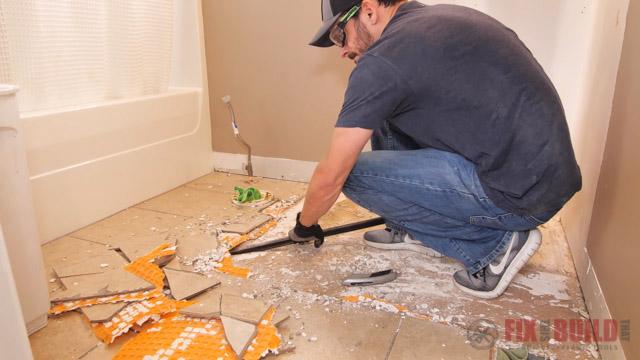 When you get near the toilet flange, slow down and take your time. The last thing you want to do is bust up your flange or worse yet snap your water supply line. Same goes for around the tub. You don’t want to damage the tub by slamming into it with a pry bar.
When you get near the toilet flange, slow down and take your time. The last thing you want to do is bust up your flange or worse yet snap your water supply line. Same goes for around the tub. You don’t want to damage the tub by slamming into it with a pry bar.
Once I had all of the flooring removed I vacuumed up the debris to see what I was left with.
Step 2: Prep Subfloor
Check Floor For Level
Now that the subfloor was clear I checked to make sure it was in good condition. Then I checked it for level, and I found there was a hump on the seam in the subfloor.

Remove Mastic
I needed to get all of the mastic off of my subfloor so started by using a scraper. After scraping the subfloor I switched to using a belt sander which worked really well.
Fix Floor Seams and Check Nails
Next I vacuumed up all the mastic and checked to see if the floors were level. Unfortunately the seams were still proud, which is a pretty common occurrence with wood subfloors.
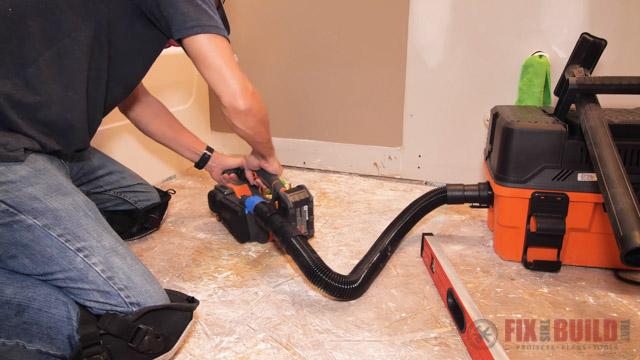
I took the belt sander to the seams to level them out the best I could. I check them frequently with my level until they were flat.
Finally I felt around and found any nails that were sticking up. Then I hammered those beneath the surface with a nailset.
There was a lot of scraping and sanding in this project and my knee pads were a lifesaver. I used the Husky Gel Soft Cap Construction Knee Pads and they were just what I needed.

I got these as part of the Home Depot ProSpective program and they worked awesome. They have a 3-point buckle system for easy adjustments so they fit most everyone. And they are comfortable with a gel inner core and a non-marring rubber cap.
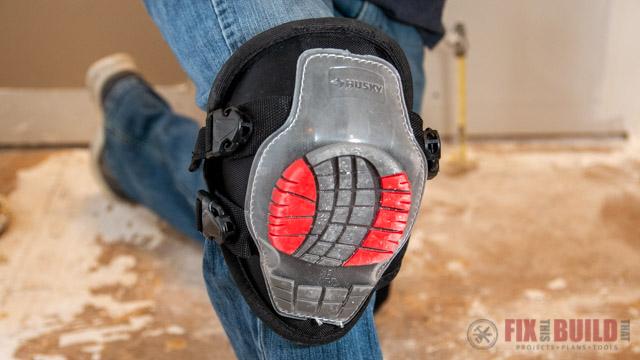 Make sure you have a pair of knee pads before you start this, or any other flooring project, you can thank me later.
Make sure you have a pair of knee pads before you start this, or any other flooring project, you can thank me later.
Step 3: Lower Toilet Flange and Add Underlayment
Lower Toilet Flange
At this point you’ll need to decide if your toilet flange needs to be lowered. The easiest way to do this is to lay a piece of your vinyl plank flooring and any underlayment you’ll be using, next to your toilet flange. Compare the height of your new floor to the height of your current toilet flange. You want to toilet flange to be flush to the flooring, or slightly proud. If your toilet flange is too high I recommend calling a plumber to lower the flange for you.
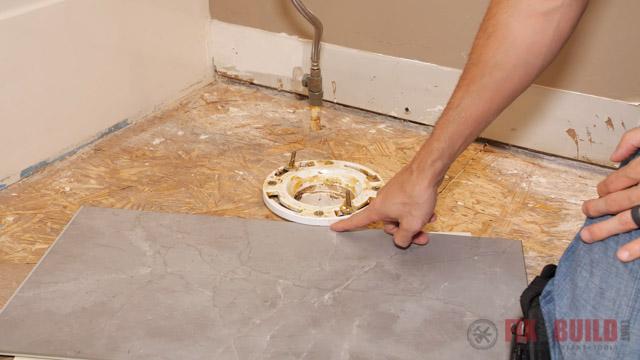
Add Silicone Caulk Along Bathtub
Before I added the plywood to my subfloor, I cleaned up the side of the bathtub. Then I laid down a new bead of silicone caulk to stop any water from getting under the tub.
Add Plywood to Subfloor
I decided to add 5mm plywood to my OSB subfloor. This was an optional step, but I wanted to have a smooth surface to work with when I installed the vinyl plank flooring. It also helped raise the floor up to the level of the toilet flange.
The plywood gets secured to the ground with staples….a lot of staples. After securing one corner I came across the sheet diagonally. This helps get good contact in the center of the sheet and then you can work your way outward to avoid humps.
Add More Silicone Caulk In Front of Bathtub
I used an ⅛” spacer between the plywood and tub and removed it and filled that gap with more silicone caulk after I was done.

I also went back and set any staples below the surface that didn’t get sunk all the way.
Step 4: Layout and Install First Row of Tiles
The vinyl plank flooring I’m using is made to look like large format ceramic tiles, complete with faux grout lines. Each tile has a barrier built in for sound dampening and you don’t need a roll out underlayment because it’s already built-in.
Plan Your Layout
You can layout your tiles in the room and take measurements to calculate offsets and minimize small pieces during install. But I prefer a more tech savvy approach. I used Sketchup to draw the room to exact dimensions and added tiles in a brick pattern.
I saw 5 rows would fit almost perfectly. Then I put dimensions on the first and last tile of a row and moved the entire floor to get an even match at the start and end.
And if you want to go a step further, which of course I did, you can add in the pipes and vents to plan around them as well.
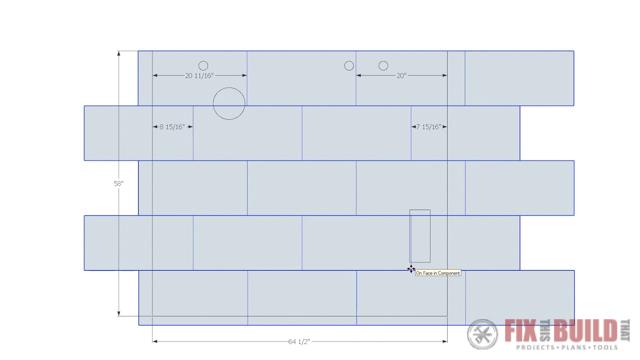
Adjust Tiles to Straight Reference Line
Installing the first row can be tricky if your wall isn’t straight. I snapped a chalk line at a right angle to the tub 5” off the wall using a carpenter’s square as reference.
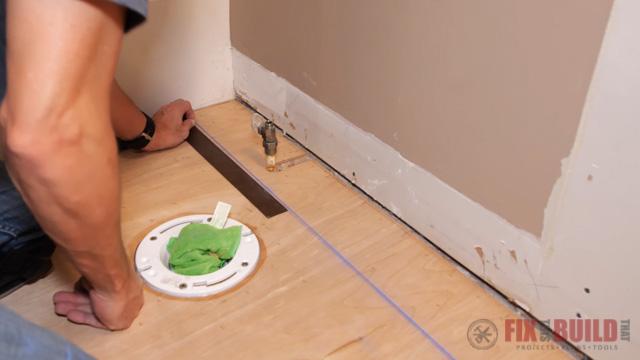
Using that line I could see the wall tapered out ½” at the far end and I marked other points along the way.
I cut the first tile to length using my layout drawing. I’m using a tile cutter for a clean edge, but you can cut this many other ways like I outlined in my 6 ways to cut vinyl flooring video.
Then I could use the points I measured to make the taper or scribe on the plank. Since the far side was ½” out, I had to take ½” off the first board to allow for a full plank at the far end.
I made the cut with my jigsaw.
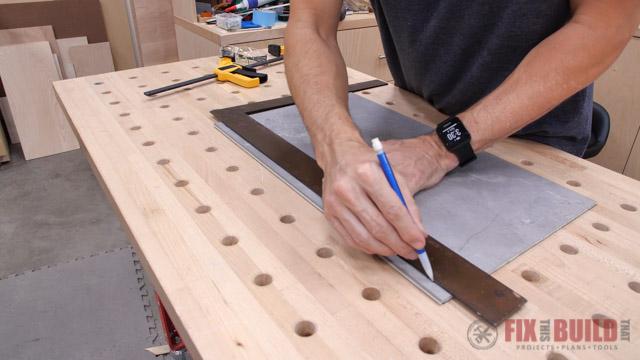
Then I brought the piece back to the bathroom to cut a hole for the water supply.
Make sure to factor in the ¼” expansion gap when you take these measurements. I used scraps of the underlayment taped to the wall as spacers.
Drill Holes For Water Lines and Toilet Flange
I drilled the spot for the water supply line using a spade bit. Then I turned off my water and took off the shut off valve to slip the piece over the pipe.
I’d bought an extra toilet flange and it turned out to be the perfect reference to trace for the cut out.

I went back to my shop and cut the curve out with a jigsaw. The jigsaw is definitely the most versatile cutting tool for vinyl flooring installs.
The piece fit in perfectly, and you’ll notice I put another ⅛” spacer against the tub since I’ll be caulking that seam at the end.
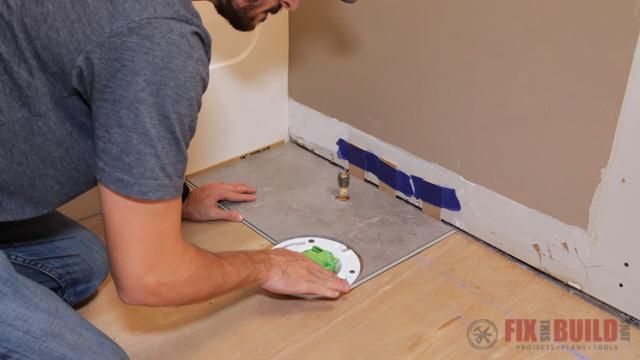
This might seem like a lot of work up front, but getting the first row right is super important and sets the stage for the rest of the install.
I repeated these same steps for the next two tiles in the first row. The 2nd piece needed a slightly offset taper as the wall had a bump out from a stud on it. And after the taper I cut a hole for the hot water pipe.
For the last piece I cut it to length then put a small taper on the front end leaving the back end at full width.
Step 5: Install and Tap Flooring Into Place
Install Vinyl Plank Flooring Around Toilet Flange
Next I cut a small tile that would hit exactly in the center of the tile in the first row. Then I put it in place. After that I used a full size piece to get the other half of the notch for the toilet flange.
I went to the shop and cut the curve out again with the jigsaw and was ready to start locking things in place.

Tap 2nd Row of Flooring Into Place
You may have noticed that I didn’t tap the first row of vinyl plank flooring into place. That’s because I wanted to wait until I had tiles for the second row laid down. Now I’m ready to start tapping them into place using a soft mallet and a tapping block. I’ll also be using a cheater’s bar when I get to the end of the rows.
I tapped the seams together with the mallet locking them in place. Then I could push the 2nd row firmly into the 1st row with the tapping block.
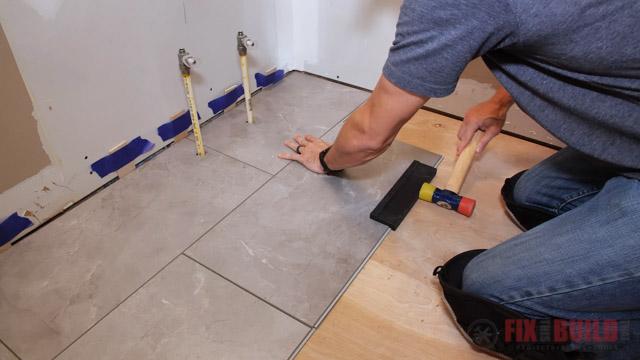 For the last piece in the row I pulled out the pull bar or cheater bar. It lets you get over the end of the tile and pull it tight into the rest of the row.
For the last piece in the row I pulled out the pull bar or cheater bar. It lets you get over the end of the tile and pull it tight into the rest of the row.

Install the Field of Vinyl Tiles
I continued down the 3rd row securing the tiles into the previous row first and tapping them tight, then locking in the short side. The last piece in the 3rd row hit the air vent in the room. Since I could lay the tile in place right over the vent it was easy to mark for the width of the cut.
Then I just measured how far up to make the opening and drew it on the tile. Then I used my jigsaw to make the cut.
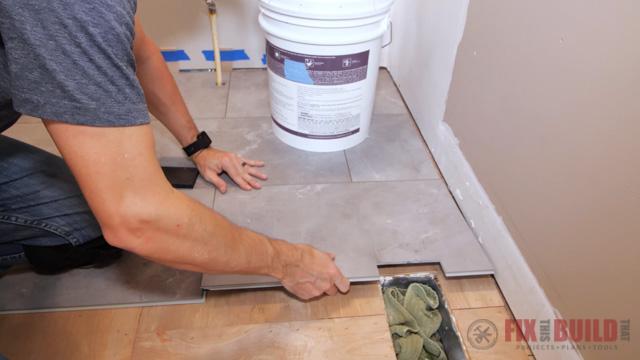
It fit in perfectly and I moved on to the fourth row.
I worked my way down the 4th row of tiles without an issue until I reached the air vent. When I planned the layout I made sure to have a full tile end right at the air vent. This makes the cuts a lot cleaner and gives the tiles more support.
Install Last Row of Vinyl Plank Flooring
The last row needs to get cut to width and scribed just like the first row. You want to leave a ¼” gap at the wall for an expansion joint as well. I cut the piece to length then measured for the scribing cuts. After a quick cut on the jigsaw it was a good fit.
You’ll have to use the cheater bar on this last row to pull it tight to the other rows just like we’ve done on the ends of each row.
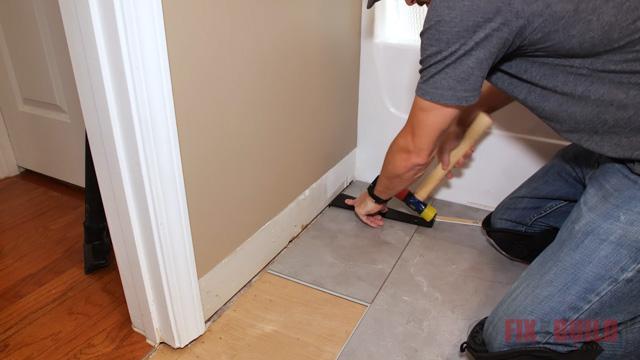
Step 6: Install Transition Piece, Trim and Silicone
I knew I wouldn’t be able to knife the final two tiles into position because of the location of my doorway in relation to the tiles. 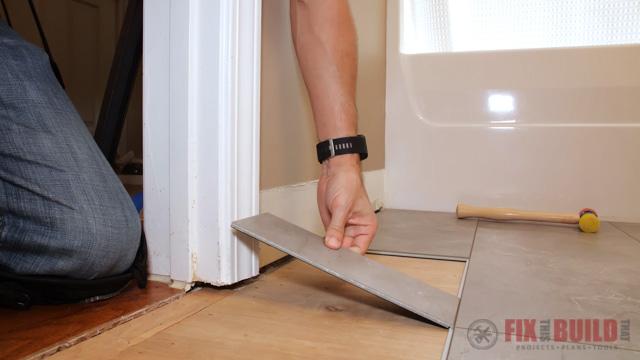
That meant I would have to install the metal c-channel for my transition strip first. Then I could taper the tiles and install the last two pieces in front of my doorway.
Install C-Channel Strip
I have a 28” door going into the bathroom and the transition strip I’m using is a t-mold that is sold in 72” lengths. It’s has two parts, the metal c-channel that gets fastened to the floor, and then the t-molding that snaps into it.
I measured a length ½” smaller than the door opening and cut down the c-channel with some tin snips. You can also use a hacksaw to cut this. When you’re positioning the transition you want to think about where it’s going to hit and if it will show or not when the door is closed.
My hardwood stops right where the face of the door will be sitting so I positioned the c-channel so the transition would just sit on top of the hardwood. I secured it with the included screws and now I could take the measurements to scribe in my last two pieces.
Install Vinyl Plank Flooring Around Door Trim
The pieces will have a little step cut in them where the door opening sticks out further than the wall. And after a quick trip to the shop with the jigsaw I had the piece cut to fit.
Then I decided to loosely lock in the tongue and groove lip on the long edge of the tile. This would allow me to use the tapping block to scoot the tile under the trim. I did this until the tile was in place.
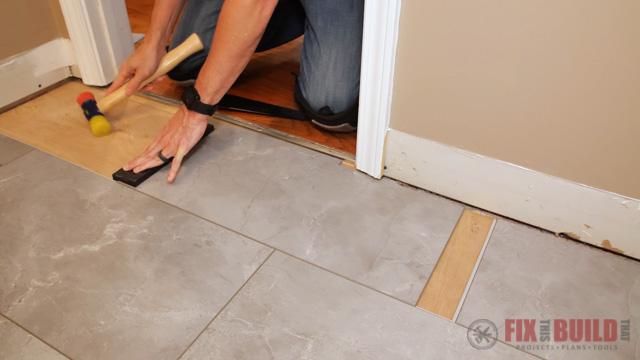
You may need to lift up on the end of the tile a little to get it to lock in, but after some mallet work it fit in like a champ.
I took the measurements on the final piece and cut it to size in the shop. I tried the same trick on the final tile, but since I didn’t have open space to the left I couldn’t really lock in the whole long edge. But after a bit of maneuvering I was able to get it all locked in.
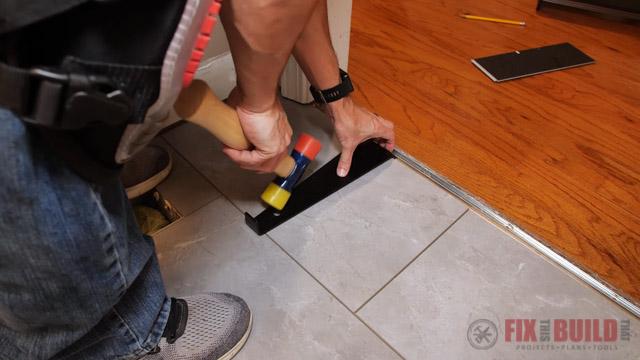
Attach Transition Piece
I went ahead and cut the transition to finish off this area. Using my miter saw gave me some chip out so I went the old fashion route with a hand saw and it worked great.
The transition pops right into the c-channel and since my door jambs were under cut for a taller floor I was able to slide the transition right under them for a clean look.
This is not the right transition for my flooring. I had to special order one which will match the floor much better and it’ll be here soon.
Add Silicone Caulk and Attach Trim
Installing the vinyl plank flooring against the tub is an important part. I left an ⅛” gap between the tub and tiles so I could fill it with silicone caulk. We found some grout colored silicone that matched pretty well and looks much better than white or clear.
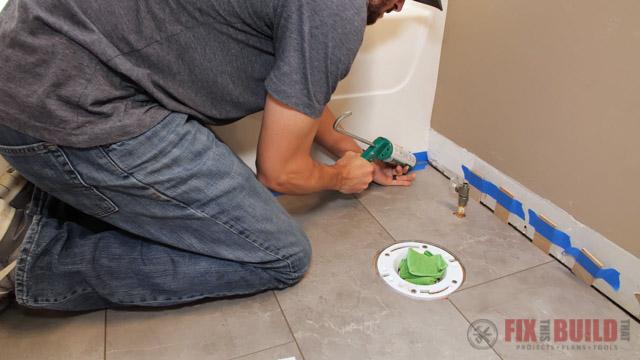
I put the taller baseboards in to finish the install and it was looking really great.
And that’s how I installed vinyl plank flooring in a bathroom! This large tile style vinyl plank flooring came out looking way better than I thought it would honestly. If you liked this project check out how I installed vinyl plank flooring in my laundry room.

 Rolex Milgauss 116400GV Blue Dial
Rolex Milgauss 116400GV Blue Dial  Rolex Sea-Dweller 126600 Mk1
Rolex Sea-Dweller 126600 Mk1 